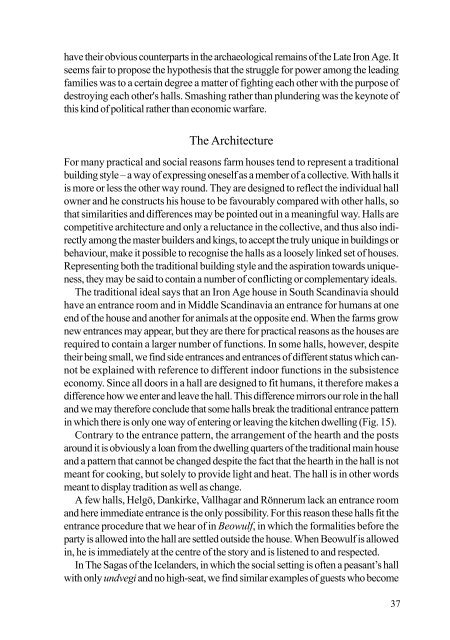Beowulf - Institutionen för arkeologi och antik historia
Beowulf - Institutionen för arkeologi och antik historia
Beowulf - Institutionen för arkeologi och antik historia
You also want an ePaper? Increase the reach of your titles
YUMPU automatically turns print PDFs into web optimized ePapers that Google loves.
have their obvious counterparts in the archaeological remains of the Late Iron Age. It<br />
seems fair to propose the hypothesis that the struggle for power among the leading<br />
families was to a certain degree a matter of fighting each other with the purpose of<br />
destroying each other's halls. Smashing rather than plundering was the keynote of<br />
this kind of political rather than economic warfare.<br />
The Architecture<br />
For many practical and social reasons farm houses tend to represent a traditional<br />
building style – a way of expressing oneself as a member of a collective. With halls it<br />
is more or less the other way round. They are designed to reflect the individual hall<br />
owner and he constructs his house to be favourably compared with other halls, so<br />
that similarities and differences may be pointed out in a meaningful way. Halls are<br />
competitive architecture and only a reluctance in the collective, and thus also indirectly<br />
among the master builders and kings, to accept the truly unique in buildings or<br />
behaviour, make it possible to recognise the halls as a loosely linked set of houses.<br />
Representing both the traditional building style and the aspiration towards uniqueness,<br />
they may be said to contain a number of conflicting or complementary ideals.<br />
The traditional ideal says that an Iron Age house in South Scandinavia should<br />
have an entrance room and in Middle Scandinavia an entrance for humans at one<br />
end of the house and another for animals at the opposite end. When the farms grow<br />
new entrances may appear, but they are there for practical reasons as the houses are<br />
required to contain a larger number of functions. In some halls, however, despite<br />
their being small, we find side entrances and entrances of different status which cannot<br />
be explained with reference to different indoor functions in the subsistence<br />
economy. Since all doors in a hall are designed to fit humans, it therefore makes a<br />
difference how we enter and leave the hall. This difference mirrors our role in the hall<br />
and we may therefore conclude that some halls break the traditional entrance pattern<br />
in which there is only one way of entering or leaving the kitchen dwelling (Fig. 15).<br />
Contrary to the entrance pattern, the arrangement of the hearth and the posts<br />
around it is obviously a loan from the dwelling quarters of the traditional main house<br />
and a pattern that cannot be changed despite the fact that the hearth in the hall is not<br />
meant for cooking, but solely to provide light and heat. The hall is in other words<br />
meant to display tradition as well as change.<br />
A few halls, Helgö, Dankirke, Vallhagar and Rönnerum lack an entrance room<br />
and here immediate entrance is the only possibility. For this reason these halls fit the<br />
entrance procedure that we hear of in <strong>Beowulf</strong>, in which the formalities before the<br />
party is allowed into the hall are settled outside the house. When <strong>Beowulf</strong> is allowed<br />
in, he is immediately at the centre of the story and is listened to and respected.<br />
In The Sagas of the Icelanders, in which the social setting is often a peasant’s hall<br />
with only undvegi and no high-seat, we find similar examples of guests who become<br />
37








